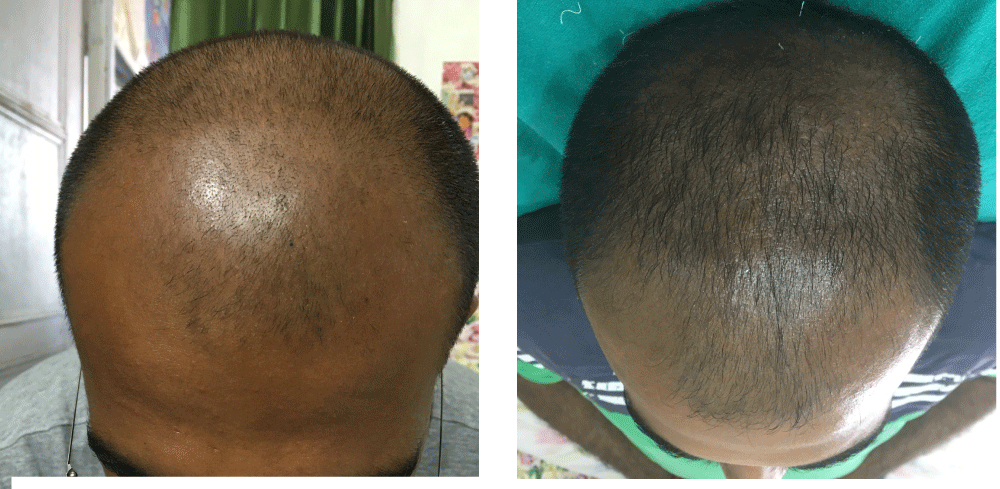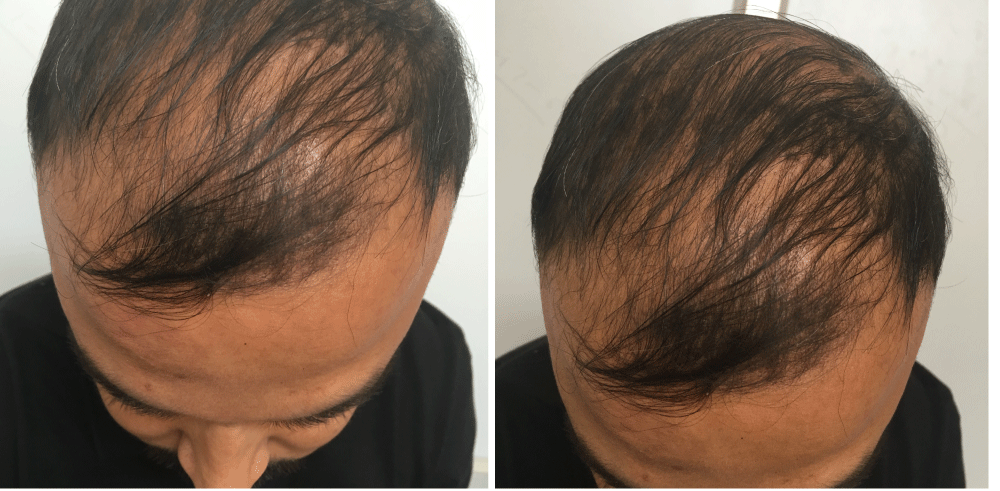International Journal of Dermatology and Clinical Research
A study on the efficacy of microneedling with minoxidil solution versus microneedling with hair multivitamin solution for the treatment of androgenetic alopecia
Neerja Puri*
Cite this as
Puri N (2020) A study on the efficacy of microneedling with minoxidil solution versus microneedling with hair multivitamin solution for the treatment of androgenetic alopecia. Int J Dermatol Clin Res 6(1): 010-012. DOI: 10.17352/2455-8605.000037Introduction: Scalp microneedling is a procedure in which various microchannels are created in the skin which have help in penetration and absorption of various agents into the skin.
Aims: To compare the efficacy of microneedling with minoxidil solution versus microneedling with hair multivitamin solution for the treatment of twenty patients of male androgenetic alopecia.
Methods: We selected twenty patients of androgenetic alopecia for the study. The patients were divided into two groups of ten patients each. In group I patients, microneedling with dermaroller was done and then minoxidil solution was applied over the scalp. In group II patients, microneedling was done and hair cocktail solution containing biotin and panthenol was used.
Results: It was seen that excellent response was seen in 15 (75%) patients in minoxidil group and 8 (90%) patients in hair cocktail group, very good response was seen in 3 (15%) patients in minoxidil group and 2 (10%) patients in hair cocktail group, good response was seen in 2 (10%) patients in minoxidil group and 6 (30%) patients in hair cocktail group and average response was seen in none of the patients in minoxidil group and 4 (20%) patients in hair cocktail group. There was a statistically significant difference between the response in the minoxidil group compared to the hair cocktail group.
Discussion: Microneedling with minoxidil is a cost effective procedure which causes hair follicle stimulation and promotes hair growth in patients of androgenetic alopecia.
Introduction
Microneedling is a promising and effective therapy for the treatment of androgenetic alopecia [1]. Minoxidil is primarily an antihypertensive which causes vasodilation. It stops hair loss and prevents hair growth in patients with androgenetic alopecia [2]. Minoxidil is a potassium channel opener which causes hyperpolarization of the cell membranes. By widening the blood vessels, it allows more oxygen, blood and nutrient to the follicle. This may cause the follicles in telogen phase to be shed which are then replaced by thicker hairs in a new anagen phase which are then replaced by thicker hairs in a new anagen phase [3]. The hair multivitamin solution contains ingredients biotin and d panthenol and it provides nutrients which nourish the hair structure and increases follicle strength and repairs dry scalp.
Aims
To compare the efficacy of microneedling with minoxidil solution versus microneedling with hair cocktail solution for the treatment of twenty patients of male androgenetic alopecia.
Material and methods
We selected twenty patients of androgenetic alopecia for the study from the patients attending dermatology OPD. The patients were divided into two groups of ten patients each. In group I patients, microneedling with dermaroller having needle length of 1.5mm was done and then minoxidil solution was applied over the scalp and the again microneedling was done. In group II patients, microneedling was done and hair multivitamin solution containing biotin and panthenol was used. A total of 8 sessions of microneedling were done every three weeks. Follow up of the patients was done for a period of six months from the last session. Written informed consent was taken from all the patients for the study. Prior permission of hospital ethical committee was taken before the start of the study. After cleaning the scalp, topical minoxidil solution was applied on the scalp and a dermaroller of 1.5mm length was rolled over the scalp in all the directions till erythema appeared, which was taken as end point.
Inclusion criteria
The following patients were included in our study:
• Patients who were non responsive to the routine therapies.
• Patients who have taken no treatment for the past 6 months.
Exclusion criteria
The following patients were excluded from our study:
• Patients on oral finasteride.
• Patients having unrealistic expectations.
• Patients having diabetes, hypertension or any other systemic disease.
Pretreatment photographs, trichogram and hair pull test was done in all the patients before the study. Baesline investigations including semen examination was done in all the patients and then at the end of last session. Physician global assessment score was used to see the response to treatment as follows:
• Excellent response - > 75% hair growth
• Very Good response-Between 50%-74% hair growth
• Excellent response-Between 25%-49% hair growth
• Excellent response-Below 25% hair growth
Subjective improvement of the patients was done by a visual analog scale (VAS score) starting from 1-10 as follows:
• Average response-Score 1-4
• Good response-Score 5-7
• Very Good response-Score 8-10
Results
The data was collected, tabulated and the results were analyzed statistically (Tables 1-3).
Discussion
Regarding the age distribution of patients, 8 (40%) patients were between 20-40 years of age and 12 (60%) patients were between 41-60 years of age. It was seen that excellent response was seen in 15 (75%) patients in minoxidil group (Figure 1,1a) and 8 (90%) patients in hair multivitamin group (Figure 2,2a), very good response was seen in 3 (15%) patients in minoxidil group and 2 (10%) patients in hair multivitamin group, good response was seen in 2 (10%) patients in minoxidil group and 6 (30%) patients in hair cocktail group and average response was seen in none of the patients in minoxidil group and 4 (20%) patients in hair cocktail group. There was a statistically significant difference between the response in the minoxidil group compared to the hair multivitamin group. Commonest side effect of microneedling was pain seen in 4 (20%) patients, bruising seen in 3 (15%) patients and folliculitis was seen in 1 (5%) patient. Regarding the patient satisfaction score, it was much higher in minoxidil group as compared to the hair multivitamin group.
Although androgenetic alopecia is a benign condition, it can significantly affect the psychology of patients [4]. It involves genetic and hormonal factors [5]. The main mechanism of androgenetic alopecia is progressive step wise miniaturization of the entire follicular apparatus [6,7]. The size of the dermal papilla determines the size of the hair bulb and ultimately the hair shaft produced. Minoxidil was introduced as a systemic treatment of hypertension. It has minoxidil sulfate which is an active metabolite, which stimulates the hair follicles. It is a potassium channel opener and its mechanism in male patterned baldness includes its vasodilator and angoigenic properties [8]. Minoxidil produces statistically significant improvement in hair count. The various multivamins in the hair multivitamin solution consisted of D-panthenol, biotin and pyridoxine. D-panthenol is also known as vitamin B5 and it contains pantethine as the bioactive form. Biotin is also known as vitamin H or B7 [9]. It is converted to carboxy biotin, acting as a cofactor in carboxylation.
In a study by Rachita et al., four men with androgenetic alopecia on minoxidil solution and finasteride since 2-5 years were subjected to microneedling procedure along with the ongoing therapy [10]. The response in the form of new hair growth was seen after 8-10 sessions. In another study, 60 patients with androgenetic alopecia were taken up out of which 30 patients were treated with minoxidil 2% solution and rest of the 30 patients were treated with intradermal injection of minoxidil 2% by point to point technique [11]. The use of mesotherapy showed more significant improvement compared with the topical minoxidil.
Microneedling causes activation of stem sells in the bulge area of the hair follicle. Microchannels created by the minoxidil, stimulates the cytokines and growth factors to accelerate the action of minoxidil on the hair follicles [12,13]. Microneedling induces hair growth by the release of platelet derived growth factor which causes platelet activation. Microneedling using minoxidil causes direct inoculation of minoxidil into the skin and therefore more powerful action.
Conclusions
Though microneedling is widely used, but all said and done, clearcut guidelines on the average number of sessions required for the treatment of androgenetic alopecia need to be further investigated. The main lacuna in our study was the small sample size. More studies with larger number of subjects need to be conducted to corroborate our findings. To conclude, microneedling is a safe and cost effective procedure which causes hair follicle stimulation and promotes hair growth in patients of androgenetic alopecia.
- Kim YC, Park JH, Prausnitz MR (2012) Microneedles for drug and vaccine delivery. Adv Drug Deliv Rev 64: 1547-1568. Link: http://bit.ly/33k8DvP
- Raj K (1990) Topical minoxidil in androgenetic alopecia, how good is it? IJDVL 56: 187-192. Link: http://bit.ly/2THDIX1
- Messenger AG, Rundegren J (2004) Minoxidil: Mechanisms of action on hair growth. Br J Dermatol 150: 186-194. Link: http://bit.ly/3aJKLUx
- Schweiger ES, Boychenko O, Bernstein RM (2010) Update on the pathogenesis, genetics and medical treatment of patterned hair loss. J Drugs Dermatol 9: 1412-1419. Link: http://bit.ly/2TFXcuX
- Tosti A, Piraccini BM (1999) Androgenetic alopecia. Int J Dermatol 38: 1-7. Link: http://bit.ly/2TVksUT
- Levy Nissenbaum E, Bar Natan M, Frydman M (2005) Confirmation of the association between male pattern baldness and the androgen receptor gene. Eur J Dermatol 15: 339-340. Link: http://bit.ly/2wLxA6X
- Whiting DA (2001) Possible mechanisms of miniaturization during androgenetic alopecia or pattern hair loss. J Am Acad Dermatol 45: 81-86. Link: http://bit.ly/2wRRRaT
- Tsuboi R, Tanaka T, Nishikawa T (2007) A randomized, placebo-controlled trial of 1% topical minoxidil solution in the treatment of androgenetic alopecia in Japanese women. Eur J Dermatol 17: 37-44. Link: http://bit.ly/2W1TfCn
- Valente Duarte de Sousa IC, Tosti A (2013) New investigational drugs for androgenetic alopecia. Expert Opin Investig Drugs 22: 573-589. Link: http://bit.ly/39JxCe2
- Dhurat R, mathapati S (2015) Response to microneedling treatment in men with androgenetic alopecia who failed to respond to conventional therapy. Indian J Dermatol 60: 260-263. Link: http://bit.ly/2W4sRrO
- Next big thing? (2014) Wendy Lewis explores the buzz surrounding skin needling. Plastic Surgery Practice 7: 24-28.
- Dhurat R, Sukesh MS, Avhad G, Dandale A, Pal A, et al. (2013) A randomized evaluator blinded study of effect of microneedling in androgenetic alopecia: A pilot study. Int J Trichology 5: 6-11. Link: http://bit.ly/2vWwFk5
- Jeong K, Lee YJ, Kim JE, Park YM, Kim BJ, et al. (2012) Repeated microneedle stimulation induce the enhanced expression of hair growth-related genes. Int J Trichology 4: 117.
Article Alerts
Subscribe to our articles alerts and stay tuned.
 This work is licensed under a Creative Commons Attribution 4.0 International License.
This work is licensed under a Creative Commons Attribution 4.0 International License.



 Save to Mendeley
Save to Mendeley
